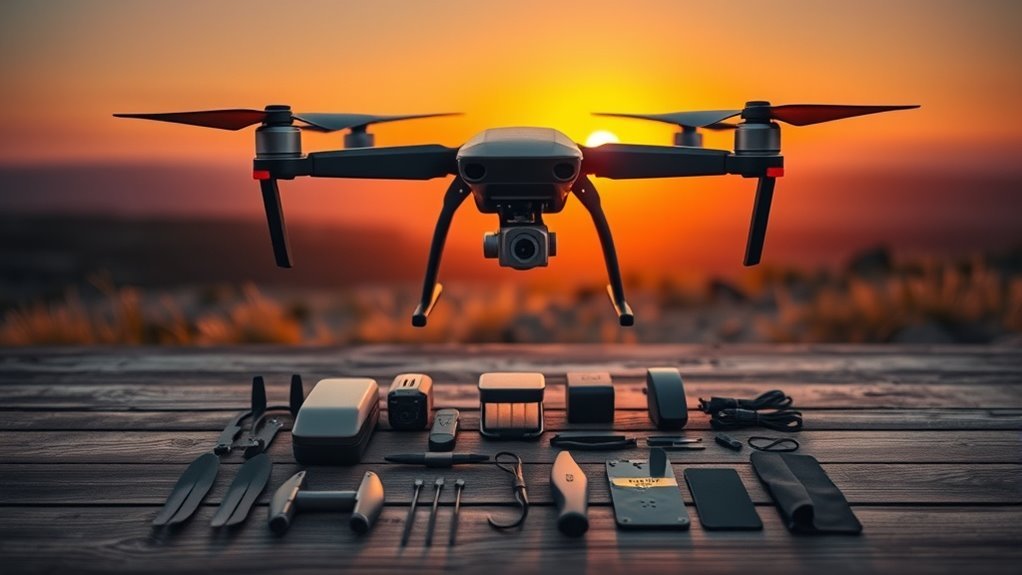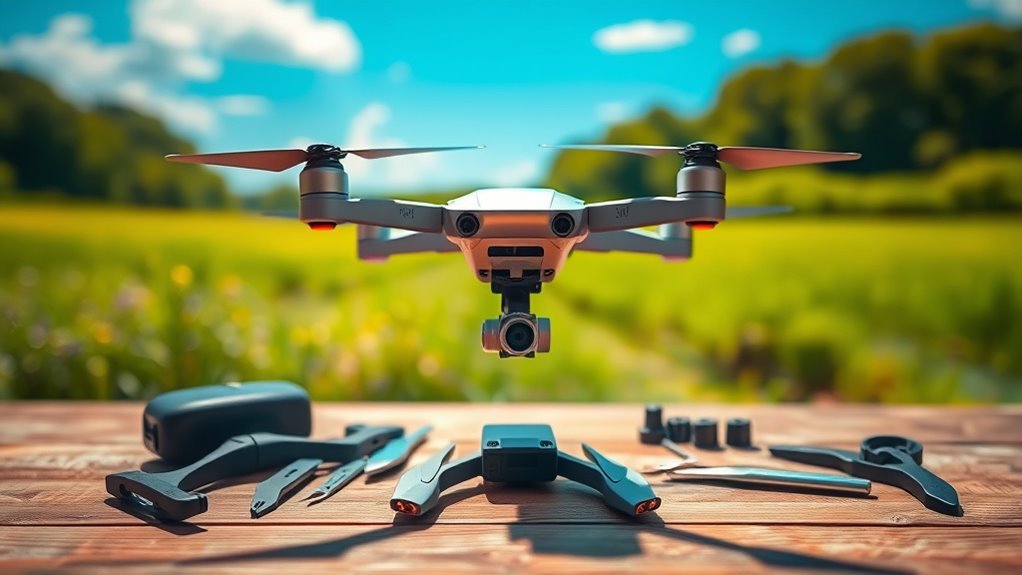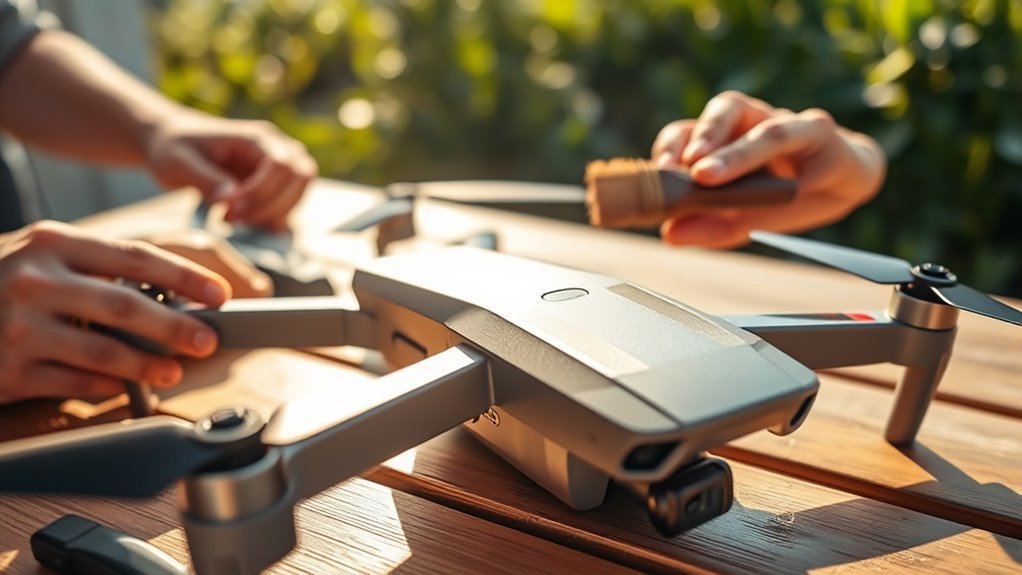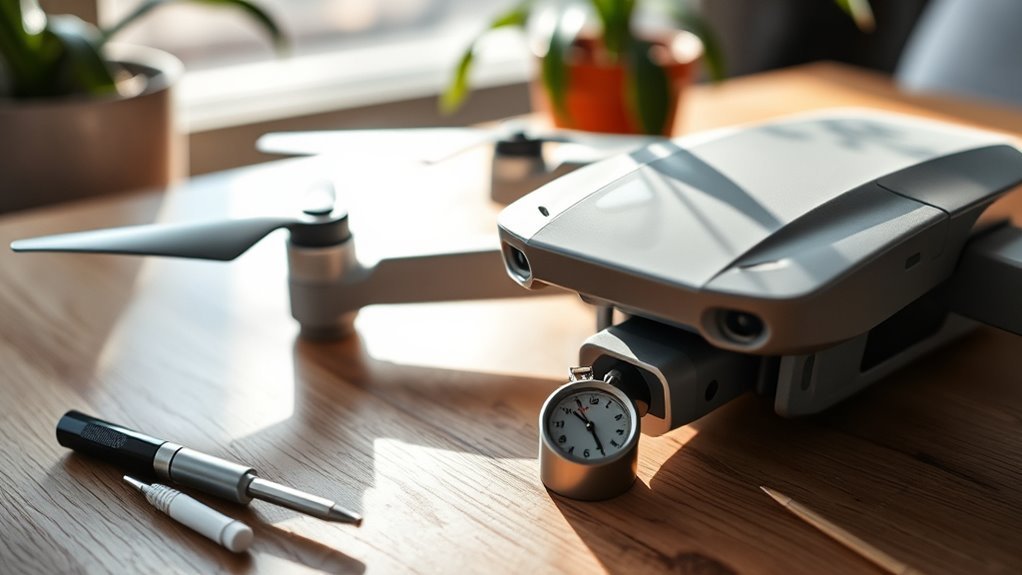Drones typically last between 1 to 6 years, depending on their type and usage. Factors like component quality, environmental conditions, and maintenance practices play significant roles in their longevity. To extend your drone’s lifespan, regularly clean its parts, inspect and replace damaged components, and guarantee software updates are current. Proper battery care is also essential for maintaining performance. For more insights on optimizing drone care and performance, you’ll want to explore further.
Understanding Drone Lifespan: An Overview

When you consider the lifespan of drones, it’s essential to recognize that multiple factors influence their durability and operational efficiency. Many enthusiasts believe in lifespan myths, such as the idea that all drones have a fixed operational life regardless of their components. In reality, drone lifespan varies considerably based on the quality of components, usage patterns, and maintenance practices. High-quality motors, batteries, and frames can extend a drone’s useful life substantially. Additionally, environmental conditions like temperature and humidity play a critical role. By understanding these dynamics, you can make informed decisions about upgrades and care, ultimately maximizing your drone’s lifespan. Embracing this knowledge empowers you to break free from misconceptions and fully enjoy your aerial experiences. Moreover, investing in advanced battery optimization can significantly improve your drone’s operational longevity. Furthermore, the choice of frequency bands can impact communication stability, which is crucial for maintaining optimal performance and extending the lifespan of your drone.
Factors Influencing Drone Longevity

When considering drone longevity, two primary factors come into play: maintenance practices and environmental conditions. Regular upkeep, including software updates and hardware inspections, greatly impacts performance and lifespan. Additionally, exposure to harsh weather or extreme temperatures can accelerate wear and tear, necessitating a careful assessment of operating environments.
Maintenance Practices
Although drones are designed for durability, their longevity heavily depends on consistent maintenance practices. Implementing effective maintenance can greatly enhance your drone’s performance and lifespan. Here are some essential practices to take into account:
- Regularly clean components using appropriate cleaning techniques.
- Check and tighten all screws and connections.
- Inspect propellers for damage and replace them as necessary.
- Perform software updates to guarantee peak functionality.
- Store your drone in a cool, dry place when not in use.
Environmental Conditions
Environmental conditions play an essential role in determining the lifespan of drones, as exposure to elements like extreme temperatures, humidity, and dust can greatly impact their performance and durability. Weather effects, including temperature extremes, can cause overheating or battery degradation, while high humidity levels may lead to moisture accumulation inside electronic components, risking short circuits. Additionally, dust exposure can clog motors and sensors, impairing flight capabilities. UV radiation from prolonged sunlight can degrade materials, weakening structural integrity. To enhance your drone’s longevity, consider operating in moderate conditions, using protective covers, and regularly cleaning components. By actively managing these environmental factors, you can considerably extend your drone’s life and maintain its peak performance, allowing you the freedom to explore the skies longer.
Different Types of Drones and Their Lifespans

When considering drone lifespans, it’s essential to distinguish between recreational and professional models. Recreational drones typically have shorter lifespans due to less durable materials and intended usage, while professional drones are engineered for longevity and resilience under demanding conditions. Understanding these differences will help you select the right drone for your needs and expectations. Additionally, knowing the typical lifespan of drones can aid in making an informed purchase decision.
Recreational Drones Lifespan
Recreational drones come in various types, each with distinct lifespans influenced by their design and usage. Understanding these differences can help you maximize your drone’s longevity.
- Quadcopter Drones: Typically last 3-5 years with proper care.
- Racing Drones: Often have a shorter lifespan of 1-3 years due to rigorous use.
- Camera Drones: Can last 4-6 years, depending on maintenance and flight conditions.
- Toy Drones: Usually last 1-2 years, primarily due to simpler construction.
- Foldable Drones: Generally last 3-5 years, offering versatility and durability.
Professional Drones Durability
While professional drones are built for durability and extended use, their lifespans vary considerably based on the specific type and intended application. For instance, drones designed for aerial photography often utilize lightweight professional drone materials, enhancing maneuverability but potentially reducing lifespan. Conversely, industrial drones, built from robust materials, can endure harsher conditions, extending their operational life. Understanding drone testing standards is essential; these standards guarantee that drones meet reliability benchmarks for performance and safety. Regular maintenance and adherence to guidelines can greatly enhance longevity. Ultimately, your choice of drone type and its application will dictate not only its durability but also how well it meets your operational demands in the field.
Common Wear-and-Tear Issues Affecting Drones
As drones are subjected to various operational conditions, common wear-and-tear issues can greatly affect their performance and longevity. Understanding these issues is vital for maximizing the lifespan of your drone components. Here are some prevalent problems:
- Battery Degradation: Reduced capacity over time affects flight duration.
- Propeller Damage: Chips or cracks can lead to instability during flight.
- Motor Wear: Bearings and windings can wear out, impacting efficiency.
- Landing Gear Stress: Frequent landings may cause structural weaknesses, particularly in collision-tolerant designs.
- Sensor Malfunction: Environmental exposure can impair sensor accuracy.
Addressing these wear-and-tear concerns proactively can help guarantee that your drone remains reliable and operational for longer periods, allowing you the freedom to explore and capture without interruption. Additionally, understanding signal attenuation is crucial for optimizing drone performance, particularly when flying in challenging environments that may cause wear on components.
Maintenance Tips to Extend Drone Life
To guarantee your drone operates efficiently and lasts longer, regular maintenance is vital. Start with drone cleaning; clear away dirt, debris, and moisture from both the exterior and internals. This prevents wear on components and guarantees peak performance. Additionally, drones like the Intel Shooting Star 2 and DJI Light Show Drone benefit from advanced processing technology, which can enhance their operational efficiency. Next, don’t overlook software updates; manufacturers often release upgrades that enhance functionality and fix bugs. Regularly checking for these updates can improve flight stability and extend the lifespan of your drone. Additionally, inspect propellers for any signs of damage or wear, as they’re essential for flight efficiency. Finally, keep all connections and components secure, avoiding any loose parts that could jeopardize performance. By adhering to these maintenance tips, you can greatly enhance your drone’s longevity and reliability. Furthermore, understanding the efficiencies of drone technology in industrial applications can provide valuable insights into optimizing your drone’s performance and lifespan.
Battery Care: Maximizing Performance and Lifespan
Proper battery care is essential for maximizing both performance and lifespan, especially since the battery is a critical component of your drone’s functionality. To guarantee your drone operates at its best, follow these guidelines:
- Monitor charging cycles to avoid overcharging.
- Store batteries in a cool, dry place to mitigate temperature effects.
- Be mindful of discharge rates during use to optimize battery health.
- Establish a maintenance schedule for regular checks on battery types and conditions.
- Adjust usage frequency to prevent premature wear. Additionally, maintaining optimal hive temperature can significantly influence the longevity of drone bees.
Signs Your Drone Needs Replacement or Repair
Battery care plays a significant role in your drone’s overall performance, but there are other indicators that signal when it’s time for a replacement or repair. Watch for drone malfunction signs such as erratic flight behavior, unresponsive controls, or unusual sounds during operation. If you notice a significant decrease in flight time or a battery that doesn’t hold a charge, these are strong repair indicators. Additionally, check for physical damage, like cracked propellers or a warped frame, which can compromise safety and functionality. Regularly inspect your drone for software updates; outdated firmware can lead to performance issues. Address these issues promptly to guarantee your drone remains reliable and continues to offer you the freedom of flight you desire. Remember that control range and battery life are crucial factors that can affect your drone’s overall performance and longevity. For example, drones such as EXO Drones can provide 20-25 minutes of flight time, significantly outperforming others in the market.
Frequently Asked Questions
Can Environmental Conditions Affect My Drone’s Lifespan?
Absolutely, environmental conditions can be a drone’s worst nightmare! Weather exposure and temperature extremes can drastically reduce your drone’s lifespan. To guarantee longevity, protect it from harsh elements and avoid extreme conditions whenever possible.
How Do Flight Patterns Impact Drone Durability?
Flight patterns greatly impact a drone’s durability. High flight frequency and aggressive maneuvering techniques can increase wear and tear, leading to potential failures. Balancing these elements is essential for optimizing performance and extending operational lifespan.
Are There Specific Brands Known for Longer-Lasting Drones?
While DJI drones are renowned for their cutting-edge technology, Parrot’s reputation for durability shouldn’t be overlooked. Depending on your needs, you might find one brand’s strengths align better with your desire for freedom and longevity.
What Accessories Can Improve My Drone’s Lifespan?
To improve your drone’s lifespan, focus on battery maintenance and invest in protective cases. Properly managing battery charge cycles and safeguarding against physical damage can greatly enhance performance and longevity, allowing you to explore freely.
How Often Should I Replace My Drone’s Parts?
You should follow a maintenance schedule to determine part replacement intervals. Regular inspections can help identify wear and tear, but generally, replace critical components like motors and batteries every 200-300 flight hours to guarantee peak performance.

